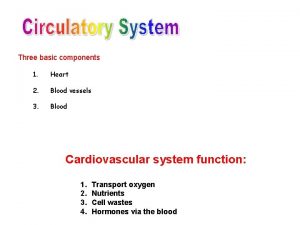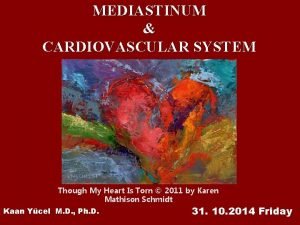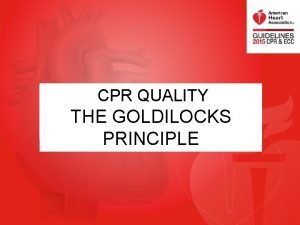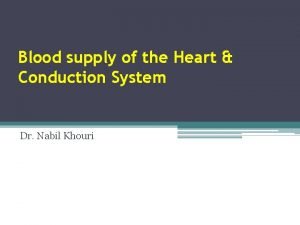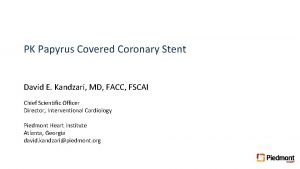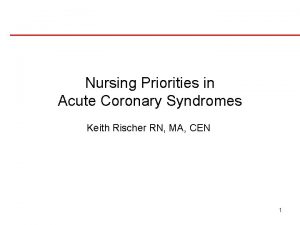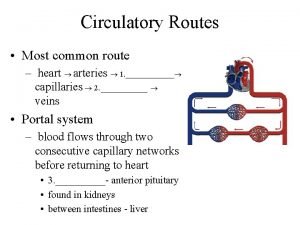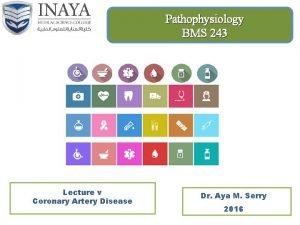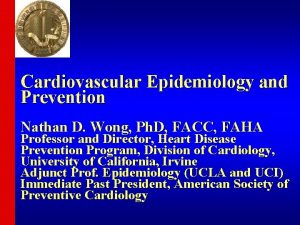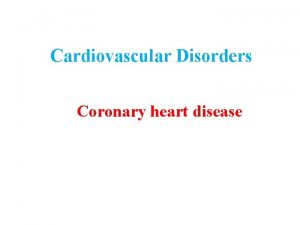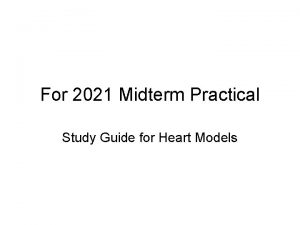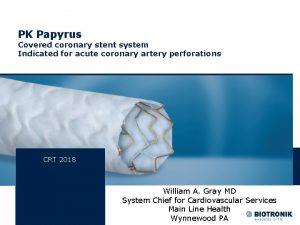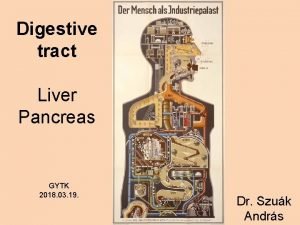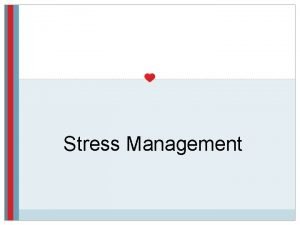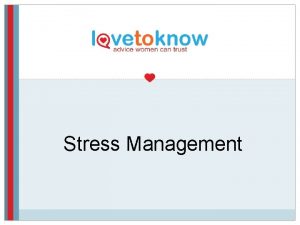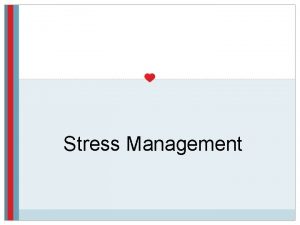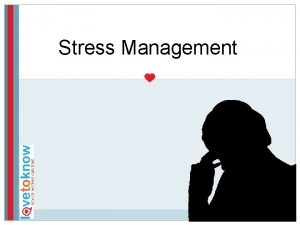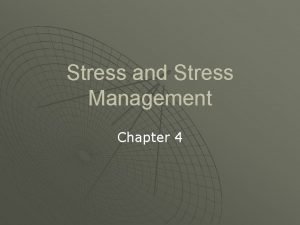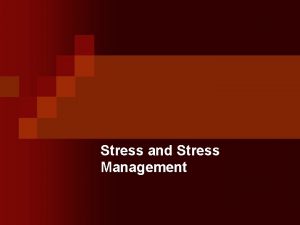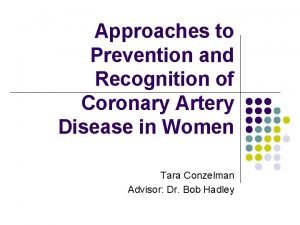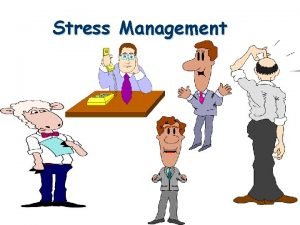Stress Management Approaches and The Prevention of Coronary





















































- Slides: 53


Stress Management Approaches and The Prevention of Coronary Heart Disease Reza Bagherian-Sararoudi Ph. D. Associate Professor, Behavioral Sciences Research Center and Department of Psychiatry, School of Medicine, Isfahan University of Medical Sciences, Isfahan, IRAN.

Introduction Many studies have demonstrated the role of psychosocial and behavioural risk factors in the aetiology and pathogenesis of cardiovascular disorders. • For Example: • Personality factors type A behaviour pattern • Type D Personality • Depression Stress

Psychological Conditions and Heart Diseases Cause or Effect? ? World Psychiatric Association: Florence, 2004

Personality The complexity of one’s personality is thought to be shaped by: – genetic factors; – family dynamics; – social influences; and – personal experiences. • • •

Personality and Stress How do personality types impact people's responses to stress? What's stressful to one person may be all in a day's work for another. Mental health professionals believe personality plays a significant role in how we perceive stress. Coping strategies as mediators between personality and stress. Regarding this issue people may be categorized into 2 types: Stress-Prone Personalities Stress-Resistant Personalities • •

Stress-Prone Personalities �� Type A behavior �� Codependent personality �� Helpless-hopeless personality �� Type D personality • •

Type A Behavior Type A personalities with a greater risk of heart attack. �� time urgency �� polyphasia �� ultra-competitiveness �� rapid speech patterns �� manipulative control �� hyperaggressiveness and free-floating Hostility Studies suggest these traits, if not properly managed, can create stress-related illnesses. Now they’ve connected another personality profile with heart problems: Type D. • • •

Type D Personality Recently, a new personality construct, the • type D or ‘distressed’ personality, has been a result of an investigation of coping styles in men with coronary heart disease. Type D personality is characterized by the • joint tendency to experience negative emotions and to inhibit these emotions while avoiding social contacts with others.

Type D characteristics Negative Affectivity: As the tendency to experience • negative emotions including dysphoria mood, anxiety, anger, and hostile. (Neuroticism) Social Inhibition: As ‘the avoidance of potential • ‘dangers’ involved in social interactions such as disapproval or non-reward by others. Type D Individuals frequently feel inhibited, tense, uncomfortable, and insecure when encounter with other people. (extraversion) Type D: As the interaction of negative affectivity (which • is closely related to neuroticism) and social inhibition.

Type D Personality In a study published in Circulation, Denollet and his • colleagues pooled 19 studies involving more than 6, 000 heart patients with Type D personalities and measured their rates of recurrent heart events compared to non–Type D individuals. Those with the Type D profile were three times more • likely to have additional heart problems, primarily heart attack or death due to heart disease, than those with more upbeat personalities.

Types A and D personalities Type D personalities may share some biological • features with the high-risk Type A group. Because they internalize their feelings, people • with negative outlooks tend to have high levels of the stress hormone cortisol, and they also harbor enhanced levels of inflammatory factors that can damage heart arteries and promote atherosclerosis.

Type D and cardiac events Type D as an independent predictor of cardiac events The inhibition of emotions has been associated with: Higher cardiovascular reactivity Lower cardiovascular recovery Lower heart rate variability Carotid atherosclerosis in the long term Incidence of coronary heart disease Cardiac mortality • • • Patients scoring high on negative affectivity and social inhibition were at four to fivefold increased risk of sudden cardiac death, after controlling for biomedical risk factors. • Type D personality (whether as a biological construct of temperament or a • constellation of habitual behaviours) is a risk factor at least equivalent in importance to the other, ‘conventional coronary heart disease prognostic factors.

Possible Mechanisms Linking Type D personality and the pathogenesis of CHD Behavioural Mechanisms . 1 Smoking Physical exercise Diet Unhealthy behaviors Stress Management • • • Biological Mechanisms: . 1 Cortisol HPA axis dysregulation psychoneuroimmunological pathways Other Possible Mechanisms • •

Cortisol has many effects that promote coronary heart disease Type D Elevated cortisol Growth hormone deficiency premature cardiovascular disease visceral fat accumulation Hypercortisolism Insulin resistance dyslipidaemia Hyperinsulinism vulnerability to cardiac illnesses.

Depression and CHD Depression and heart disease are common • conditions and often occur together. However, until recently, little was known about the relationship between the two. Now there is evidence to show that depression • can be as big a risk factor for heart disease as smoking, high cholesterol levels and high blood pressure. As well, depression can affect the recovery of • people with heart disease and increase their risk of further heart problems.

What are the links between depression and heart disease? A review of evidence by the Heart Foundation 2 shows that: • Depression is a significant risk factor for heart disease. • Depression is also linked with conventional risk factors for heart disease — for example, people with depression are more likely to smoke. • Depression is more common among people with heart disease. • Depression affects recovery and increases the risk of further heart-related incidents, such as heart attack and sudden death. • •


Low Social Support People who do not have good social support • networks(e. g. someone to confide in, opportunities to participate in social activities) are also at greater risk of developing heart disease.

Stress What Causes Stress? Stress can be caused by a physical or emotional change, or a change in your environment that requires you to adjust or respond. Things that make you feel stressed are called "stressors. " Stressors can be: minor hassles, major lifestyle changes, or a combination of both. • • • Being able to identify stressors in your life and releasing the • tension they cause are the keys to managing stress.

some common stressors Illness, either personal or of a family member or friend. Death of a friend or loved one. Problems in a personal relationship. Work overload. Starting a new job. Unemployment. Retirement. Crowded Pollusion Noise Pregnancy. Crowds. Relocation. Daily hassles. Legal problems. Financial concerns. Perfectionism • • • • •

Possible Mechanisms Linking Psychological factors and the pathogenesis of CHD How Does Psychological factors Increase the Risk for Heart Disease? Behavioural Mechanisms . 1 Quality of Life • Unhealthy behaviors • Compliance • Complicating treatment • For example, if you are under stress, your blood pressure goes up, you may overeat, you may exercise less, and you may be more likely to smoke. Biological Mechanisms: Cortisol HPA axis dysregulation psychoneuroimmunological pathways Arrhythmia Haemostasis Other Possible Mechanisms . 1 • • •

Type D and psychoneuroimmunological pathways Inflammatory processes play an important role in • atherosclerotic diseases. The pathophysiological mechanisms accounting for the • relationship between psychological factors and CAD progression may involve immunological processes. Psychological risk factors for CAD can be classified into three categories, based on their duration and temporal proximity to coronary syndromes: •

Three categories of psychological risk factors for CAD Acute psychological risk factors: such as outbursts of anger can act • as triggers of myocardial infarction by inducing cardiac ischemia and promoting plaque rupture in advanced stages of CAD. Episodic psychological risk factors: such as major depressive • disorder and exhaustion, are transient (with a duration ranging from several weeks to 2 years) and are recurring. Episodic factors are involved in the transition from stable to unstable atherosclerotic plaques. Chronic psychological risk factors: Stable characteristics, such as • hostile personality, Type D, and low socioeconomic status, are associated with elevated long-term risk of first myocardial infarction. Chronic psychological risk factors are important at early disease stages,



Type D As A Chronic Psychological Risk Factor Sympathetic nervous system-mediated pro-atherogenic processes, including increased lipid deposition and inflammatory processes, are among the pathophysiological pathways accounting for the association between personality factors and early stages of CAD. • Hostility, one of the most extensively examined chronic psychological • CAD risk factors, is purportedly associated with impaired phagocytic function of macrophages correlates with elevated pro-inflammatory cytokines • Chronic psychological factors also promote development of episodic • psychological risk factors and are associated with increased reactivity to acute.

Stress Management techniques = coping strategies training Stress Management techniques means coping • strategies training. Coping strategies are the ways for reducing • stress and negative emotions.

Definition of the word cope How you can increase your level of coping skills, so • let's break it down. First, we need to define the word cope. Cope; to deal successfully with a difficult problem or • situation. Therefore, increasing your coping skills translates into improving your ability to deal with a difficult problem.


Do type D individuals need treatment? Psychological interventions: Cognitive behavioural therapy Social skills training Emotional support Interpersonal psychotherapy Progressive muscle relaxation Autogenic training Diaphragmatic breathing Guided imagery Various forms of meditation Hypnosis Biofeedback Exercise • • • All reduce stress in type D persons and improve their ability to socialize. Antidepressants may possibly help some type D individuals. SSRI: decrease harm avoidance (a tendency to respond intensely to signals of aversive stimuli), increase social confidence, and decrease hostility.

How Can I Cope With Stress? After you've identified the cause of stress in your • life, the next step is to learn techniques that can help you cope with stress while fighting heart disease. There are many techniques you can use to manage stress. Some of which you can learn yourself, while other techniques may require the guidance of a trained therapist. Some common techniques for coping with stress • include:

Intrapersonal Skills Managing thoughts Anger management Negative thinking Pleasant activities Relaxation skills Decision-making Problem-solving Planning for emergencies • •

Relaxation skills (Anxiety) Relaxation may be a useful way of coping with various • circumstances such as stress, tension, anxiety, anger, sleeplessness. Skills training involves alternate tensing and relaxing of • various muscle groups, to enable clients to identify tension states and their alternative, relaxation. In addition to relaxation of muscle groups, clients are taught slow breathing and the use of calming imagery. As these skills are practiced and acquired, clients can be taught to apply them in various situations, stressful ones in particular.

Assertiveness training May be offered to enable clients to express their emotions • and opinions clearly and directly, in a manner that leaves them satisfied that their views were heard, but without doing so in a way that alienates or antagonizes others. Assert yourself. You do not have to meet others' • expectations or demands. Remember, being assertive allows you to stand up for • your rights and beliefs while respecting those of others and reducing your stress.

Negative thinking (Depression) Separate skills training sessions are available for increasing • one’s awareness of negative thinking and for managing it when it occurs. Clients are taught to recognize various types of negative thinking habits that may occur automatically. Skills for managing negative thoughts include substituting positive thoughts or feelings, thought stopping, and positive self-talk. Exercises give clients practice in identifying their negative • thinking and negative self-talk, and provide an opportunity for them to prepare alternative, substitute responses. A related common problem is negative moods and/or depression.

Anger management (Hostility) Anger is a very common antecedent to CHD. • Clients are taught about the warning signs of anger, both external and internal signs, so they can identify them early and begin to manage them before anger grows strong and becomes harder to control. • Skills for managing anger include the use of calm-down • phrases, identifying aspects of a situation that are provoking anger, and considering options that might help to resolve the situation. These skills can be modeled by therapist and then role-played by the client. For homework, clients are asked to record their handling of • the next anger situation they encounter.

Pleasant activities People may also find that they are leading an unbalanced • lifestyle in which they fulfill numerous obligations, with little if any time devoted to recreation or self-fulfillment. A session on developing a pleasant activities plan is intended • to help clients prepare enjoyable, low-risk ways of filling the free time that will be opened up, and achieve a better balance between their obligations and more enjoyable or self-fulfilling activities. A number of strategies for selecting and engaging in these • activities are identified.

Intimate relationships Some people may experience difficulty expressing their feelings, or communicating effectively and sensitively in intimate relationships. This can be a bar to intimacy, both emotional and sexual. Clients are taught about self disclosing their emotions, sharing their positive feelings, and the importance of expressing negative feelings (in an appropriate way) to prevent things from building up. They may also be taught listening skills, which are an essential component of an intimate relationship. Clients practice these skills in simulated situations drawn from their recent past in which they felt angry, anxious, or sad with loved ones. Homework involves planning how to handle one such situation, and then actually trying out the skills in it. • • •

Enhancing social support network Support from others often makes people feel more confident about their ability to cope with problems. A good social support network can enhance the chances of coping effectively. They are asked to consider the various types of support that might be helpful to them, who might be helpful in providing the support they need, and how to go about developing that support. They are also taught about the importance of reciprocity, i. e. , lending support to others as part of the process of building one’s support network. They are given practice asking for support with particular problems, and offering to support others with their problems. • • •

Problem-solving This is a ‘generic’ skill, not specifically related to chemical • dependence. It is recommended to include it among the skills being trained, to provide a means of coping if clients unavoidably enter a difficult situation for which they have no apparent coping response immediately available. The steps in the problem-solving model include problem recognition, identification of the problem’s component elements as precisely as possible, brain storming potential solutions, selecting the most promising approach, trying it out, assessing its adequacy, and refining the plan if necessary. With this skill, clients are provided a way of coping with • unanticipated problems that might otherwise stump them and put them at high risk for Stress.

General social skills A number of additional social skills may also be taught to help clients • better handle social situations that might otherwise put them at risk for stress. Various communications skills (e. g. , how to start conversations, use of • nonverbal behavior) may be taught to help clients cope with deficits in communications that could leave them feeling socially inadequate or isolated.

Stop smoking Aside from the obvious health risks of • cigarettes, nicotine acts as a stimulant and brings on more stress symptoms.

Exercise regularly Choose non-competitive exercise and set • reasonable goals. Aerobic exercise has been shown to release endorphins (natural substances that help you feel better and maintain a positive attitude. )

Take responsibility Control what you can and leave behind what • you cannot control. Perceived personal Control and Self-Esteem •

Reduce causes of stress Many people find life is filled with too many • demands and too little time. For the most part, these demands are ones we have chosen. Effective time-management skills involve • asking for help when appropriate, setting priorities, pacing yourself, and taking time out for yourself.

Examine your values and live by them The more your actions reflect your beliefs, the • better you will feel, no matter how busy your life is.

Set realistic goals and expectations Perfectionism • It's OK, and healthy, to realize you cannot be • 100% successful at everything all at once.

Sell yourself to yourself When you are feeling overwhelmed, remind • yourself of what you do well. Have a healthy sense of self-esteem.

Get enough rest Even with proper diet and exercise, you can't • fight stress effectively without rest. You need time to recover from exercise and stressful events. The time you spend resting should be long • enough to relax your mind as well as your body. Some people find that taking a nap in the middle of the day helps them reduce stress.

Pray Are you a religious or spiritual person? • If you are (or even if you’re not but have • considered trying), praying can be tremendously helpful in times of extreme stress.

Enhancing Self Esteem What is Low Self Esteem? • Low self esteem results from a poor self image. Your self image is based on how you see yourself. Do you think you are a good, reliable, hardworking, honest or friendly person? Low self esteem feeds your negative thinking and makes you • believe negative comments others make. This can cause you to lose confidence so it is vital to end negative thoughts if you want to build your self esteem. What is High Self Esteem? • High self esteem is the opposite of the above! If you have a high • level of self esteem you will be confident, happy, highly motivated and have the right attitude to succeed.

 Primary prevention secondary prevention tertiary prevention
Primary prevention secondary prevention tertiary prevention Individual approaches to stress management
Individual approaches to stress management Chapter 10 stress responses and stress management
Chapter 10 stress responses and stress management True strain formula
True strain formula Define axial stress
Define axial stress Coronary groove
Coronary groove Coronary sulcus
Coronary sulcus Coronary personality
Coronary personality Tricuspid valve
Tricuspid valve Coronary sinusoids
Coronary sinusoids Coronary groove of heart
Coronary groove of heart Coronary artery disease
Coronary artery disease What is high quality cpr
What is high quality cpr Crux cordis
Crux cordis Coronary steal syndrome
Coronary steal syndrome Annulus of vieussens
Annulus of vieussens Great cardiac vein
Great cardiac vein Global registry of acute coronary events
Global registry of acute coronary events Classification of antianginal drugs
Classification of antianginal drugs Pk papyrus covered coronary stent system
Pk papyrus covered coronary stent system Worm like amphibian
Worm like amphibian Acute coronary syndrome
Acute coronary syndrome Coronary ligament
Coronary ligament Coronary blood flow
Coronary blood flow Anemia or hypoproteinemia will ______ blood viscosity.
Anemia or hypoproteinemia will ______ blood viscosity. Coronary artery disease pathophysiology
Coronary artery disease pathophysiology Mesa coronary calcium score
Mesa coronary calcium score Heart disease
Heart disease Crash course circulatory system
Crash course circulatory system Heart cycle animation
Heart cycle animation Coronary circulation of heart
Coronary circulation of heart Where is the pulmonary semilunar valve located
Where is the pulmonary semilunar valve located Mesa coronary calcium score
Mesa coronary calcium score Coronary heart disease
Coronary heart disease Thebasian veins
Thebasian veins Coronary calcium score guidelines
Coronary calcium score guidelines Qfr coronary
Qfr coronary Pulmonary semilunar valve
Pulmonary semilunar valve Pk papyrus stent
Pk papyrus stent Bursa omentum
Bursa omentum Coronary circulation
Coronary circulation Classical approaches to management
Classical approaches to management According to chester barnard an organization is
According to chester barnard an organization is Change and stress management
Change and stress management Change and stress management
Change and stress management Motivation and stress management
Motivation and stress management Hát kết hợp bộ gõ cơ thể
Hát kết hợp bộ gõ cơ thể Frameset trong html5
Frameset trong html5 Bổ thể
Bổ thể Tỉ lệ cơ thể trẻ em
Tỉ lệ cơ thể trẻ em Gấu đi như thế nào
Gấu đi như thế nào Chụp tư thế worms-breton
Chụp tư thế worms-breton Alleluia hat len nguoi oi
Alleluia hat len nguoi oi Môn thể thao bắt đầu bằng chữ f
Môn thể thao bắt đầu bằng chữ f





